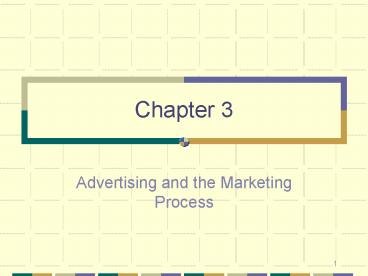Advertising and the Marketing Process - PowerPoint PPT Presentation
1 / 17
Title:
Advertising and the Marketing Process
Description:
Chapter 3 Advertising and the Marketing Process What is Marketing? The American Marketing Association Defines Marketing as the Process of Planning and Executing the ... – PowerPoint PPT presentation
Number of Views:35
Avg rating:3.0/5.0
Title: Advertising and the Marketing Process
1
Chapter 3
- Advertising and the Marketing Process
2
What is Marketing?
- The American Marketing Association Defines
Marketing as the Process of Planning and
Executing the Conception, Pricing, Promotion, and
Distribution of Ideas, Goods, and Services to
Create Exchanges That Satisfy the Perceived
Needs, Wants, and Objectives of the Customer and
the Organization.
3
The Marketing Plan
A Marketing Plan is a Blueprint of Planned
Marketing Activity That Strives to Create a
Competitive Advantage for an Individual Product,
a Product Line, or an Idea.
Research Stage Analyze Marketing Environment
Strategic Stage Develop Objectives and Strategies
Tactical Stage Specific Tools Are Selected
Implementation Stage Coordinate Strategy With
Marketing Activities
Evaluation Stage Assess How Well Objectives Were
Achieved
4
Advertisings Role in the Marketing Plan (Fig.
3.1)
Advertising is One of Several Marketing
Communication Options.
5
The Four Main Types of Marketing (Fig. 3.2)
6
Approaching the Market
7
Product Differentiation
- A Competitive Marketing Strategy Designed to
- Create Product Differences in the Eyes
- of the Consumer.
Intangible Differences Image That Implies
Difference such as Status, Enjoyment or
Masculinity
Tangible Differences Product Features, Color,
Size, Quality of Performance, Options or Price
8
Marketing Concept
- The marketing concept suggests that marketing
should focus first on the needs and wants of the
customer, rather than finding ways to sell
products that may or may not meet customers
needs. - Step 1. Determine what the customer needs and
wants. - Step 2. Develop, manufacture, market, and
service the goods and services that fill those
particular needs and wants.
9
Integrated and Relationship Marketing
- Integrated marketing has emerged as the strategic
approach with the greatest potential to implement
the marketing concept. - Relationship marketing identifies high-value
customers and prospects and bonds them to the
brand through personal attention. - Advertising, along with other communication
tools, can play an important role in maintaining
relationships.
10
Four Tools of Marketing
11
Product Branding
12
Channel of Distribution Influencers
Market Coverage?
Push, Pull or Combo Strategy?
Channel Direct or Indirect?
- Exclusive Distribution Only one distributor is
allowed to sell the brand in a market area.
i.e.Ethan Allen - Selective Distribution Increased number of
outlets, but limit number to most profitable.
i.e. Timex - Intensive Distribution Places product in every
possible outlet. i.e. soft drinks
- Push Strategy Directs marketing efforts at
resellers. - Pull Strategy Directs marketing efforts to the
ultimate consumer. - Combination Strategy Most often used and
combines push and pull strategies.
- Direct Marketing Companies that distribute
products without the use of a reseller. - Indirect marketing product is distributed
through a channel structure that includes one or
more resellers.
13
Pricing
The Price a Seller Sets for a Product is Based
Not Only on the Cost of Making and Marketing the
Product, But Also on the Sellers Expected Profit
Level.
14
Marketing Communication Mix
Advertising
Personal Selling
Packaging
How the Marketer May Communicate With Target
Markets.
Point-of- Sale
Sales Promotion
Public Relations
Direct Marketing
15
Marketing Communication
- Personal Selling
- Face-to-face contact between the marketer and a
prospective customer. - Most important for companies that sell products
requiring explanation, demonstration, and
service. - Advertising
- Has a greater ability to reach a larger number of
people simultaneously. - Has less ability to prompt an immediate change in
behavior. - Sales Promotion
- Communication devices offered for a limited
period of time to generate immediate sales.
16
Marketing Communication
- Public Relations
- Set of activities intended to enhance the image
of the marketer to create goodwill. - Direct Marketing
- Interactive system that allows two-way
communication. - Provides a mechanism for the prospect to respond.
- Can occur at any location.
- Provides a measurable response.
- Requires a database of consumer information.
- Point-of-Sale/ Packaging
- All the communication devices and marketing
messages found at the place where the product is
sold.
17
Why Hire an Agency?
- Hiring an agency can result in several benefits
- Offer objective advice.
- Draw on the collective experience and training of
its staff. - Provide people and management skills to
accomplish advertising objectives. - Provide supportive environment for professional
advertising people.































